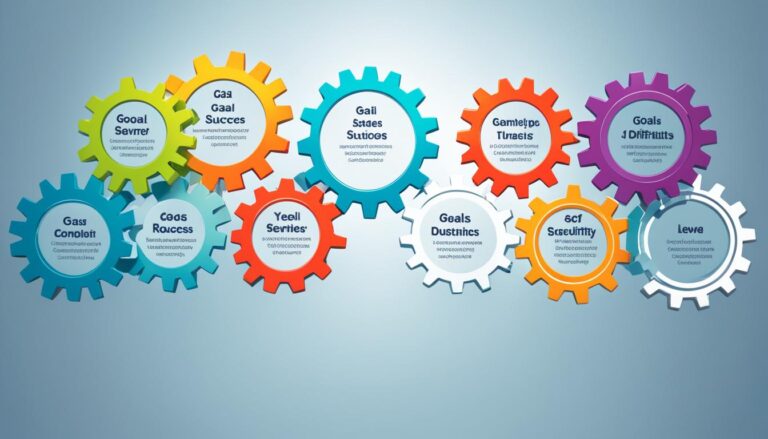Maximize Limited Means with Decision Making Skills

Do you ever feel frustrated by the slow pace and uneven quality of decision-making processes? Are you facing challenges when it comes to making important choices with limited resources? It’s time to unlock the power of decision making skills to overcome these obstacles and achieve optimal outcomes.
In today’s fast-paced and resource-constrained world, decision making plays a vital role in maximizing limited means. Whether you are a manager, an executive, or an individual faced with tough choices, the ability to make effective decisions can make all the difference.
In this article, we will explore the impact of limited means on decision making, the necessity of decision-making abilities, overcoming constraints in decision making, different types of decisions, and the rational decision-making model. By the end, you’ll have a deeper understanding of how decision making skills can empower you to navigate limited means and achieve success.
Key Takeaways:
- Effective decision making is crucial when dealing with limited means.
- Developing strong decision-making skills enables individuals to optimize their choices within resource constraints.
- Recognizing and addressing constraints in decision making is essential for making informed decisions.
- Understanding the distinction between programmed and nonprogrammed decisions helps approach them effectively.
- The rational decision-making model provides a framework for maximizing decision quality.
The Impact of Limited Means on Decision Making
When faced with limited resources, decision making becomes a complex and challenging process. Executives and decision makers often find themselves having to make critical choices with constraints that can significantly impact the outcome. Limited means can manifest in various ways, including scarcity of financial resources, time constraints, or even restricted access to information. Such limitations pose unique challenges that require individuals to think critically and navigate decision making with constraints.
In these situations, decision makers often encounter information overload, making it difficult to filter through the noise and identify the most relevant data. Moreover, unclear organizational roles and responsibilities can further complicate the decision-making process, causing delays and inefficiencies. Additionally, an overreliance on consensus can hinder effective decision making, as it may prioritize consensus over sound judgment and innovative thinking.
One industry that exemplifies the impact of limited means on decision making is healthcare. Healthcare professionals often face high-pressure situations where critical choices must be made swiftly, and the stakes are exceptionally high. They must carefully allocate resources, distribute personnel, and make crucial decisions within a fast-paced and resource-constrained environment.
Developing strong critical thinking skills is vital in order to navigate decision making in limited resources effectively. Critical thinking enables individuals to analyze and evaluate information critically, identify biases, and make informed decisions based on the available resources and constraints. It encourages innovative problem-solving and helps overcome challenges posed by limited means.
By incorporating critical thinking into the decision-making process, individuals can optimize their decisions in limited situations. They can strategically analyze the available information, prioritize tasks, and make sound judgments despite the limitations they face. Critical thinking allows decision makers to explore alternative perspectives, challenge assumptions, and adopt a solution-oriented mindset.
| Challenges | Impact |
|---|---|
| Information overload | Difficulty in filtering relevant data and making informed decisions |
| Unclear organizational roles | Delays and inefficiencies in decision making |
| Overreliance on consensus | Prioritizing agreement over critical thinking and innovative solutions |
In conclusion, decision making with limited means requires individuals to think critically and navigate challenges effectively. By developing strong critical thinking skills and embracing alternative perspectives, decision makers can optimize their choices and achieve positive outcomes even when resources are scarce. The ability to make informed decisions in limited situations is essential for success in today’s dynamic and competitive environment.
The Necessity of Decision Making Abilities
When faced with limited resources, decision making abilities become a necessity to optimize your choices. These abilities enable you to make the best decisions possible within the constraints you are dealing with.
Whether you are choosing the most cost-effective option or prioritizing tasks based on limited time and resources, effective decision making skills empower you to optimize your decisions. It allows you to navigate the challenges of limited means and achieve the best outcomes possible.
Optimizing Decisions in Resource Constraints
Decision making with limited resources requires you to carefully evaluate and prioritize your options. By analyzing the available resources and constraints, you can make informed choices that maximize the utility of what is available to you.
For example, in a business setting, decision making skills help you determine how to allocate limited budgets effectively. By assessing the potential return on investment and considering alternative solutions, you can make decisions that generate the greatest value.
Similarly, in personal life, decision making abilities aid in managing time and resources efficiently. Whether it is deciding which tasks to prioritize or making choices that align with your long-term goals, effective decision making allows you to optimize your actions.

By honing your decision making abilities, you can navigate the complexities of limited resources with confidence, knowing that your choices are optimized for the best possible outcomes.
Embracing the Challenge
Decision making in resource constraints may seem daunting, but it presents an opportunity for growth and creativity. The limitations force you to think critically, explore alternative solutions, and make the most out of what you have.
Although constraints can be perceived as obstacles, they can also spark innovation and ingenuity. When resources are scarce, decision making skills allow you to find inventive ways to meet your goals, often leading to unexpected and impactful solutions.
In conclusion, decision making abilities are vital when dealing with limited resources. By optimizing decisions in resource constraints, you can make the most of what you have and achieve optimal outcomes. Embrace the challenge and leverage your decision making skills to navigate the complexities of limited means successfully.
Overcoming Constraints in Decision Making
Decision making with limited means requires you to overcome various constraints. These constraints may include time, available information, and mental capacity. It’s common for individuals to utilize bounded rationality in decision-making processes when faced with constraints, meaning they aim to satisfice rather than optimize. However, it’s crucial to recognize and address these constraints in order to make informed decisions that lead to the best possible outcomes.
One way to overcome constraints in decision making is by understanding the power of process. By implementing a structured decision-making process, you can ensure that all important factors are considered and weighed against one another. This empowers you to make more rational and comprehensive decisions even when resources are limited.
Another effective strategy is to utilize heuristics, which are mental shortcuts or rules of thumb that simplify complex decision-making processes. Heuristics can help you quickly assess and prioritize information, allowing you to make decisions more efficiently. However, it is important to use heuristics with caution and be aware of any potential biases they may introduce.
Navigating Decision Making with Limited Means
Here are some practical tips to help you navigate decision making with limited means:
- Identify the key constraints and limitations you are facing. This could include time constraints, lack of resources, or insufficient information.
- Prioritize your decision criteria based on the importance and relevance to the situation.
- Consider alternative solutions and evaluate them based on the available resources and constraints.
- Seek input and perspectives from others who may have additional knowledge or insights.
- Utilize structured decision-making frameworks such as the rational decision-making model or SWOT analysis to guide your thinking.
- Learn from past experiences and continuously improve your decision-making skills to adapt to different situations.

Achieving Optimal Decisions
Overcoming constraints in decision making requires a combination of critical thinking, creativity, and adaptability. By recognizing the limitations and utilizing effective strategies, you can navigate decision making with limited means more effectively and achieve optimal decisions.
| Constraints | Strategies to Overcome |
|---|---|
| Time constraints | Set clear deadlines, prioritize tasks, and delegate when necessary. |
| Information constraints | Seek additional information, conduct research, and gather relevant data to make more informed decisions. |
| Mental capacity constraints | Take breaks, practice mindfulness, and leverage the expertise of others to alleviate cognitive load. |
Different Types of Decisions
When it comes to decision-making, not all decisions are created equal. There are different types of decisions that individuals make within organizations, and understanding these distinctions is crucial for approaching them effectively. Let’s explore two primary types of decisions: programmed decisions and nonprogrammed decisions.
Programmed Decisions
Programmed decisions are routine decisions that occur frequently and have established decision rules. These decisions are predictable and repetitive, allowing individuals to utilize predefined procedures or guidelines to make choices. Programmed decisions are often made in response to recurring problems or situations, enabling organizations to streamline processes and increase efficiency.
Nonprogrammed Decisions
On the other hand, nonprogrammed decisions are unique and important decisions that require conscious thinking and careful consideration of alternatives. These decisions can be complex and ambiguous, with no established rules or procedures to follow. Nonprogrammed decisions often involve strategic planning, problem-solving, and critical thinking, as they have a significant impact on the organization’s success.
It is essential for individuals to recognize the distinction between programmed and nonprogrammed decisions. By understanding the nature of each type, individuals can apply the appropriate decision-making approaches and strategies to achieve the best outcomes.

| Programmed Decisions | Nonprogrammed Decisions |
|---|---|
| Repetitive and routine | Unique and important |
| Follow established decision rules | Require conscious thinking and careful consideration |
| Examples: Inventory management, scheduling | Examples: Strategic planning, crisis response |
The Rational Decision-Making Model
The ability to make rational decisions is crucial in maximizing the quality of your choices. The rational decision-making model provides a structured approach for making informed decisions. By following a series of steps, you can enhance your decision-making process and increase the likelihood of achieving desired outcomes.
The rational decision-making model consists of the following steps:
- Establishing decision criteria: Begin by defining the criteria that will guide your decision. These criteria serve as benchmarks for evaluating alternative choices.
- Generating alternatives: Once decision criteria are established, brainstorm and create a list of possible alternatives. Consider different perspectives, options, and solutions.
- Evaluating each alternative: Evaluate each alternative against the established decision criteria. Analyze the potential benefits, drawbacks, and consequences of each option.
While implementing the rational decision-making model can lead to better decisions, it is important to be aware of the challenges that may arise, particularly during the alternative generation step.
Challenges in Alternative Generation
One of the key challenges in the alternative generation step is the tendency to rely on limited or obvious choices. People often have a natural inclination to stick with familiar options, which can limit creativity and hinder the exploration of potentially better alternatives. Overcoming this challenge requires open-mindedness and the willingness to consider unconventional ideas and viewpoints.
Furthermore, time constraints and limited resources can also impede the generation of a wide range of alternatives. However, by leveraging techniques such as brainstorming, mind mapping, and seeking input from diverse perspectives, you can overcome these challenges and expand the pool of potential options.

| Rational Decision-Making Model | Challenges |
|---|---|
| 1. Establish decision criteria | Limited or obvious choices |
| 2. Generate alternatives | |
| 3. Evaluate each alternative | Time constraints and limited resources |
Conclusion
In conclusion, decision making skills are crucial when dealing with limited means. By improving your decision-making processes, you have the power to maximize your resources and achieve the best possible outcomes. It is important to recognize and understand the constraints and challenges that come with decision making in limited situations. By utilizing effective decision making models and strategies, you can navigate through these limitations and make choices that lead to success.
Decision making with limited means requires a combination of critical thinking and creativity. You must learn to work with the available resources, prioritize tasks, and make the most cost-effective decisions. By developing your decision-making abilities, you can optimize your choices and achieve your goals despite limited means. Remember, it’s not the amount of resources you have, but how you use them that matters.
To improve your decision making skills, it is essential to embrace a rational decision-making model. Establish decision criteria, generate alternatives, and evaluate each option against the criteria. This systematic approach ensures that you consider all relevant factors and make informed decisions. By following this model, you can avoid hasty and impulsive choices, and instead make well-thought-out decisions that align with your goals.
In summary, decision making skills play a crucial role in maximizing limited means. Recognize the constraints, challenges, and opportunities that come with decision making in limited situations. Embrace effective decision-making models and strategies to navigate these limitations. With the right mindset and techniques, you can make informed choices that lead to success, regardless of the resources at your disposal.






